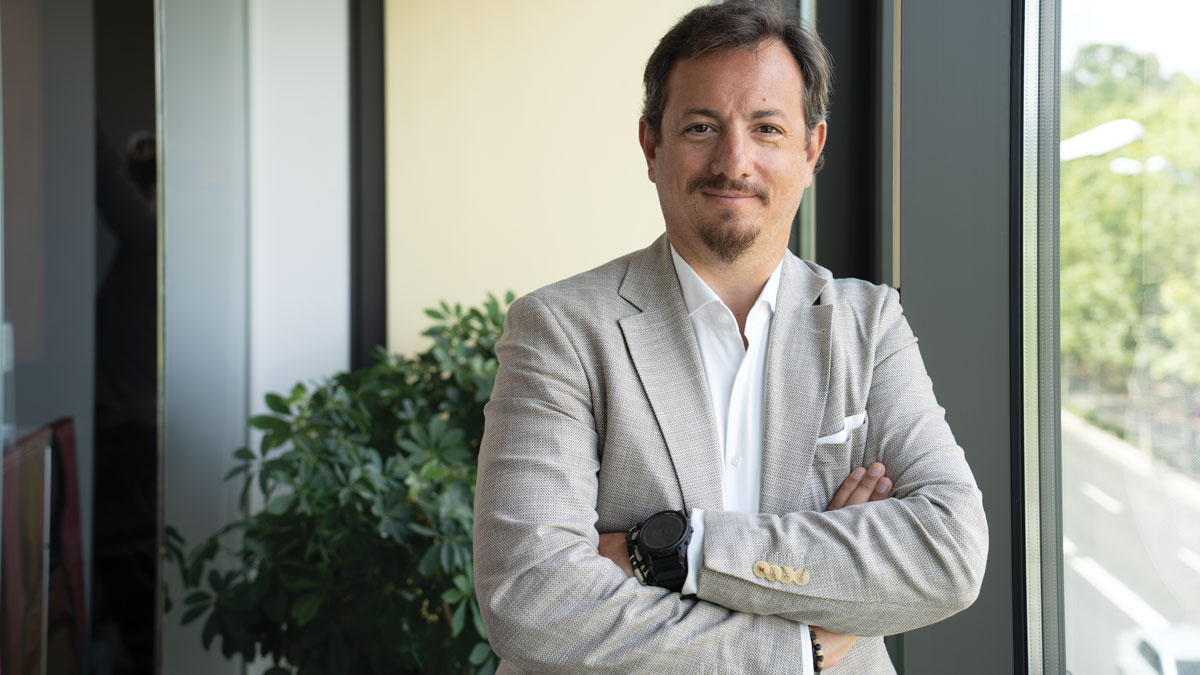Ciprian Glodeanu, Equity Partner of Glodeanu & Partners: Romania’s Prospects for the Renewable Energy Market
Ciprian Glodeanu is currently the Equity Partner of Glodeanu & Partners, a boutique law firm highly specialized in Real Estate, Energy and Infrastructure projects set up in April 2019. Previously, for 13 years he was a Partner of Wolf Theiss Bucharest, an international law firm and coordinated the Real Estate, Infrastructure and Energy practices. His experience includes advising on renewable and conventional energy projects.
In 2012, Ciprian founded the Romanian Photovoltaic Industry Association (RPIA) whose purpose is to create a business environment for networking among Romanian and international authorities and also all the other foreign and Romanian companies involved in the PV supply chain. In the same year Ciprian was appointed President of RPIA and was acting as such until October 1st, 2021.
Ciprian was a legal advisor for clients such as: Vestas, Enel GP, Trina Solar, Photon Energy, Bester, Lukoil, Ikea, Obton, R Power, OX2, Renesola, Enery, Contur Global, Claritas and many others.
How is the renewable energy market in Romania evolving? How favourable is the legal framework for green investments? Which tools could be most useful for financing the energy industry and the strategy of Romania for achieving the energy targets undertaken at the EU level? These are just a few issues discussed with Ciprian Glodeanu – Equity Partner of Glodeanu & Partners, in an interview on Romania’s prospects for the renewable energy market.
Dear Ciprian Glodeanu, considering your extensive expertise in the energy field, how do you find Romania’s energy contribution on regional and European markets?
Ciprian Glodeanu: Romania has made and is making significant contributions to both regional and European energy markets.
We are a major player in the energy sector, particularly in electricity production (specifically renewable energy) and natural gas. Romania has a diverse energy mix, a significant portion of the electricity generated being from renewable sources such as hydro, wind and solar.
Romania’s strategic location in Eastern Europe allows it to serve as a hub for natural gas pipelines, enhancing energy security in the region. Romania continues its efforts to modernize the energy infrastructure and increase energy efficiency and therefore have its role further solidified in the European energy market.

As Europe is moving towards a mass adoption of renewable energy, Romania will have to follow this trend. Please comment a bit on the legal framework. Does it encourage/facilitate investments in green energy in our country?
Ciprian Glodeanu: The legal framework for green energy investments in Romania is generally favourable, but it also faces certain challenges and uncertainties.
Among the favourable aspects it is worth mentioning: the energy legislation, the incentives, and the alignment to the EU requirements.
Energy legislation, in general, and renewable energy legislation, in particular are aimed to promote and support the development of renewable energy sources.
After the green certificates support scheme, currently Romania is moving forward towards a more sophisticated and sustainable incentive arrangement, being anticipated to shortly launch the first round of renewable-energy auctions under the contracts for difference (CfD) scheme, with EBRD support.
Furthermore, as a member of the European Union (EU), Romania is required to work toward meeting EU targets for renewable energy production and emissions reduction.
Also, the legislation has seen multiple steps being taken forward in terms of the permitting process. I have to note that despite the local “specifics”, the authorization process is one of the shortest in Europe.
According to ANRE, Romania’s installed capacity will increase by around 35% by 2030 compared to 2020, due to the deployment of new wind (2,302 MW by 2030) and solar (3,692 MW by 2030) capacity. What measures do you see to speed up the permitting process for renewable energy projects?
Ciprian Glodeanu: Speeding up the permitting process for renewable energy projects is crucial to attract investment and accelerate the transition to clean energy.
Among the measures that can be implemented to achieve this goal one can think at:
- One-Stop Shops – establishing one-stop shops or dedicated units within regulatory agencies to handle all necessary permits and approvals for renewable energy projects can eliminate the need for developers to navigate multiple agencies and processes.
- Electronic Permitting – digitize the permitting process by allowing online submission of applications and electronic communication between regulators and developers. This can improve efficiency as well as transparency.
- Time Limits for Review and Predictable Timelines – establish and enforce clear time limits within which regulatory bodies must complete their reviews and issue the relevant permits, as well as establishing predictable timelines for each permitting stage. This can prevent indefinite delays and encourage timely decision-making and planning accordingly in order to anticipate delays.
- Clear Guidelines and Regulations – last but not least, clear and up-to-date guidelines for renewable energy projects, ensuring that developers understand the requirements and expectations from the outset are paramount for a healthy development of the renewable energy sector.
By combining these measures, regulatory bodies can create a more favourable environment for renewable energy investments thus reducing the time and uncertainty associated with the permitting process.
Though Romania has passed a new law to shorten the permitting process for solar projects installed on less than 50 hectares of buildable land, developers and investors in the industry are facing the current interpretation at the level of the Ministry of Agriculture whereby the construction of renewable energy projects on extra muros land surface areas of more than 50 hectares is forbidden, even if the investor/developer has carried out the zoning procedure of changing the land from extra muros into intra muros. Law 166/2023 does not bring any arguments to contradict this interpretation, and the exception under Land Law 18/1991 remains under debate until further legislative clarity is provided. What is your viewpoint on this issue?
Ciprian Glodeanu: It is indeed one of the current major challenges in terms of development of renewable energy projects, mainly of photovoltaic projects. However, I would say that the market adapted, and we found ways to move forward with our projects, irrespective of these impediments.
It would be ideal if the legislation would be further clarified, but, in the meantime, projects are advancing and developers, investors and financing entities appear to have understood and tailored business plans accordingly.

What other impediments do investors/developers face currently?
Ciprian Glodeanu: Despite its potential, developers and investors face several impediments and most of them would be undoubtedly overcome with the support of the legislative and regulatory institutions involved. Also, these challenges are not unique to Romania and can be found in various degrees in different countries.
Out of these impediments, it is worth mentioning:
- Changes in regulations creates uncertainty for investors. Frequent policy changes can undermine investor confidence and affect the feasibility of renewable energy projects.
- Lengthy and complex permitting processes can result in project delays and increased costs. Environmental impact assessments and other regulatory approvals take significant time to obtain.
- Difficulties in connecting renewable energy projects to the electricity grid can cause delays and impact project viability. Limited grid capacity and technical challenges are amongst the major hurdles.
- Ambiguity or lack of clarity in the regulatory procedures and requirements can lead to confusion among investors and developers, potentially causing project delays.
- Access to financing, especially for smaller developers, can be an obstacle as well.
- Shortage of skilled professionals, including engineers, technical experts and project managers specialized in renewable energy can impede project development.
- Delays or difficulties in securing necessary technology components and equipment, especially for emerging or less common renewable technologies, can hinder project progress.
- Finally, bureaucratic challenges and administrative burdens are one of the major slowdowns for project development and increase costs.
How are the costs of renewable energy technologies, including storage, evolving? Are they viable to meet profit targets even in a lower-priced energy market?
Ciprian Glodeanu: The costs of renewable energy technologies, including storage, are generally decreasing in Romania, as they are in many parts of the world. However, the viability of these technologies to meet profit targets in a lower-priced energy market depends on various factors, including the specific technology, project scale, financing terms and regulatory framework.
The costs of PV systems, including both equipment and installation, have been declining globally. Advances in technology and economies of scale have contributed to lower costs, making solar energy more competitive. Wind turbine technology has likewise become more cost-effective over the years, with larger and more efficient turbines being developed. Onshore and offshore wind projects have benefited from these improvements.
Energy storage technologies, such as batteries, are experiencing cost reductions, although they tend to lag behind solar and wind in terms of price decline.
It’s worth noting that as renewable energy technologies become more cost-competitive and storage solutions continue to improve, they are better positioned to contribute to the energy mix even in lower-priced energy markets. Developers and investors often evaluate projects based on their specific financial models and risk assessments to determine whether they can achieve profit targets over the life of the project.
What about the labour market in this field?
Ciprian Glodeanu: The labour market in the renewable energy field is experiencing growth and demand for skilled professionals across various sectors of the industry.
The renewable energy sector requires a diverse range of skilled professionals, including engineers, project managers, technicians, researchers, policy experts, legal advisors, and more. The rapid growth of the renewable energy sector has led to a skills gap, with a shortage of qualified professionals in some regions. This gap is most pronounced in emerging technologies and specialized areas. Addressing the skills gap requires targeted training and education programs that provide individuals with the knowledge and skills needed for renewable energy careers.
Many countries are investing in research and development related to renewable energy technologies, creating opportunities for scientists and researchers to contribute to innovation in the field.
However, the global nature of the renewable energy industry means that professionals with the right expertise may have opportunities to work in different countries on various projects.
To sum up, the labour market in the renewable energy field has been dynamic and growing, driven by the global transition to cleaner energy sources. While opportunities exist, addressing the skills gap and keeping up with technological advancements and regulatory changes remain important challenges for the industry.
Currently, renewable energy investment is on the rise in Romania. What are the prospects for the Romanian renewable energy market?
Ciprian Glodeanu: The prospects for the Romanian renewable energy market are generally positive, with increasing investment and a growing interest in transitioning to cleaner energy sources. Romania has significant renewable energy potential, including solar, wind, biomass, and hydropower resources.
Romania, as a member of the European Union (EU), is committed to achieving its renewable energy targets as set out in various EU directives. For 2030, the share of renewable energy in total production is 30.7% and is thought to be increased to a minimum of 34%.
Furthermore, the EU’s commitment to the European Green Deal and its emphasis on achieving carbon neutrality by 2050 could provide additional incentives and funding for renewable energy projects in Romania.
However, it’s important to consider potential challenges and uncertainties as well that were mentioned above.
Romania’s transition to green energy represents a major opportunity for banks and technical installation companies. Yet, there are a lot of delays in construction projects. Which tools could be most useful for financing the energy industry and the strategy of Romania for achieving the energy targets undertaken at the EU level?
Ciprian Glodeanu: Financing the energy industry and achieving energy targets at the EU level requires a combination of policy tools, financial mechanisms, and strategic planning.
Here are some tools that can be useful for both aspects:
- CfDs: The recently announced CfD scheme is a long-awaited support mechanism benefiting from massive interest from investors in renewables and financing banks.
- Power Purchase Agreements (PPAs): PPAs are contracts between energy producers and consumers or off-takers. They can provide long-term revenue certainty for renewable energy projects.
- Guarantees of origin (GOs): GOs have been designed at EU level to support the financial viability of renewable energy projects and stimulate investments in the renewable energy sector.
Additionally, there are strategic planning tools such as the National Energy and Climate Plans (NECPs), energy roadmaps, and energy efficiency programs which can be used to support the development of the sector.
Romania can also access various EU funding programs to support its energy strategy and meet its targets, such as the PNRR and the Modernization Fund.
For a successful energy transition and achieving EU energy targets, a combination of financial tools, strategic planning, regulatory frameworks, and international collaboration is essential. Romania’s energy strategy should align with its national priorities, market conditions, and the evolving energy landscape.








